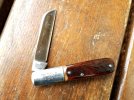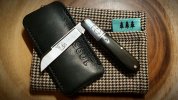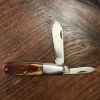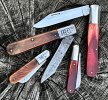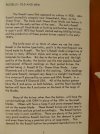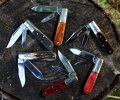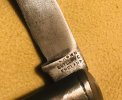-
The BladeForums.com 2024 Traditional Knife is ready to order! See this thread for details: https://www.bladeforums.com/threads/bladeforums-2024-traditional-knife.2003187/
Price is$300$250 ea (shipped within CONUS). If you live outside the US, I will contact you after your order for extra shipping charges.
Order here: https://www.bladeforums.com/help/2024-traditional/ - Order as many as you like, we have plenty.
You are using an out of date browser. It may not display this or other websites correctly.
You should upgrade or use an alternative browser.
You should upgrade or use an alternative browser.
What Makes a Good, Traditional Barlow?
- Thread starter waynorth
- Start date
OtisCampbell
Gold Member
- Joined
- Dec 3, 2008
- Messages
- 277
Fodderwing
Gold Member
- Joined
- Jan 31, 2017
- Messages
- 9,182
Great shape I reckon! What a beauty. Wow!Anyone have a notion about this Cattaraugus 2139 Barlow? It’s in great shape which makes me think more recent vintage.. Thanks in advance!
View attachment 1990669
Old Engineer
Gold Member
- Joined
- Nov 30, 2014
- Messages
- 10,048
I have a few Original Russells . Exact age on them is Unknown. Of the ones in the photo :Does anyone have experience with what the springs were like on the old Russell barlows?

The Top One appears to have had Not been used or abused as hard as The Bottom one . The bottom one even has a broken blade . The reason that I even bought it is because it was the First Russell that I ever found and only cost me $5 .
The pull on the bottom one is maybe a 1 - 2 whereas the pull on the top ones is maybe a 3 - 4 . It is hard to tell whether the Springs have lost some their power or if the rubbing between the Blade and Spring has caused wear that has reduced the amount of Deflection of the Springs which in turn would Reduce the Pull .
Harry
Frank.K
Gold Member
- Joined
- Apr 2, 2021
- Messages
- 366
Thanks Harry,I have a few Original Russells . Exact age on them is Unknown. Of the ones in the photo :

The Top One appears to have had Not been used or abused as hard as The Bottom one . The bottom one even has a broken blade . The reason that I even bought it is because it was the First Russell that I ever found and only cost me $5 .
The pull on the bottom one is maybe a 1 - 2 whereas the pull on the top ones is maybe a 3 - 4 . It is hard to tell whether the Springs have lost some their power or if the rubbing between the Blade and Spring has caused wear that has reduced the amount of Deflection of the Springs which in turn would Reduce the Pull .
Harry
I’d like to add one to the collection. I like strong springs though, so it’s hard to buy online. I definitely noticed some rounding of the tang on my GEC 71 after some years of use.
If I understand what you are saying, it is that as the spring and the tang wear down, there is less metal holding the spring under tension, so the spring relaxes, resulting in a softer pull. Thanks again, this gives me something to think about. I hope more people weigh in.
Fodderwing
Gold Member
- Joined
- Jan 31, 2017
- Messages
- 9,182
Old Engineer
Gold Member
- Joined
- Nov 30, 2014
- Messages
- 10,048
I have an older Taylors Eye Witness that I can see that the end of the blade that rubs the spring looks like it probably missed the proper heat treat and has worn so much that he blade is almost floppy loose . There is still a very thin edge that did not contact the spring . On a blade that has half/stops and a strong pull , you can use a small file and file down the corner of the blade that touches the spring and reduce the amount of deflection of the spring to reduce the pull to some degree . Not as easy to do as it is to say , but it can be done .Thanks Harry,
I’d like to add one to the collection. I like strong springs though, so it’s hard to buy online. I definitely noticed some rounding of the tang on my GEC 71 after some years of use.
If I understand what you are saying, it is that as the spring and the tang wear down, there is less metal holding the spring under tension, so the spring relaxes, resulting in a softer pull. Thanks again, this gives me something to think about. I hope more people weigh in.
I wish you Good Luck on finding a nice Old Original Russell . There are many Commemorative Russells out there that are nice and then there are the newer made Russells , and then there are some others . Do yourself well and study up on what an Original Russell looks like . Zero in on the word RUSSELL , it must be in a Straight Line and not curved , Tip of Arrow can not be in line with the pivot pin , and pay attention to the Cover Pins Locations .
Top one is a Commemorative one and bottom one is an Original .


Harry
Frank.K
Gold Member
- Joined
- Apr 2, 2021
- Messages
- 366
Tip of Arrow can not be in line with the pivot pin
I see the pin is below the axis of the blade. It’s a good design I think. When you pierce with the blade it should favor staying open.
Most of the ones Ive seen have a curved stamp, so maybe not original, but they appear to be old. I’ll just keep my eyes open, with luck some day I might have one. For me searching is a lot of the fun anyway.
Old Engineer
Gold Member
- Joined
- Nov 30, 2014
- Messages
- 10,048
The Later real Russells do have a Curved Stamp but then it does get a little tricky . It is all about Where the Little Arrow in that stamping starts . And that is the Vintage of Real Russells that I Do Not Have to show you . I have not been able to find one for what I would pay for it . That Vintage would be around 1934 to ????I see the pin is below the axis of the blade. It’s a good design I think. When you pierce with the blade it should favor staying open.
Most of the ones Ive seen have a curved stamp, so maybe not original, but they appear to be old. I’ll just keep my eyes open, with luck some day I might have one. For me searching is a lot of the fun anyway.
Harry
Will Power
Gold Member
- Joined
- Jan 18, 2007
- Messages
- 33,462
Old Engineer
Gold Member
- Joined
- Nov 30, 2014
- Messages
- 10,048
Thanks for posting this information . The Foot Missing under one Leg of the " R " is something that I was Not Aware of . I just suspected that it was Worn Tooling ....only as a supplement to what has already been written...
View attachment 1993710View attachment 1993711View attachment 1993712
Harry
Fodderwing
Gold Member
- Joined
- Jan 31, 2017
- Messages
- 9,182
These two York - Dutch Barlows have several differences. Completely different tang marks. One much thicker than the other. Difference in blades. One has a longer bolster than the other. One with one blade tang stamp and the larger one with both blades stamped (which I suppose makes it the oldest of the two). Both are very well made with robust build.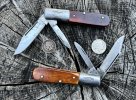
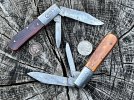
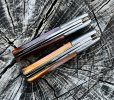
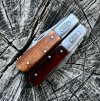




bigfish64
Gold Member
- Joined
- Apr 9, 2020
- Messages
- 9,800
Great looking Barlows Dwight.These two York - Dutch Barlows have several differences. Completely different tang marks. One much thicker than the other. Difference in blades. One has a longer bolster than the other. One with one blade tang stamp and the larger one with both blades stamped (which I suppose makes it the oldest of the two). Both are very well made with robust build.View attachment 1994341View attachment 1994342View attachment 1994339View attachment 1994340
Augie
Gold Member
- Joined
- Aug 23, 2014
- Messages
- 3,936
Thanks for posting this information . The Foot Missing under one Leg of the " R " is something that I was Not Aware of . I just suspected that it was Worn Tooling .
Harry
Harry, Russell did use up their bolster stamps which is why you see such a variety of sharpness to the Russell arrow, my understanding is the fletching on the arrow would be the first to go, I have an example where the fletching is almost gone.
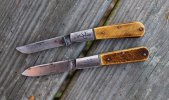
waynorth
Knifemaker / Craftsman / Service Provider
- Joined
- Nov 19, 2005
- Messages
- 33,181
Where is that information found, JoKr???...only as a supplement to what has already been written...

